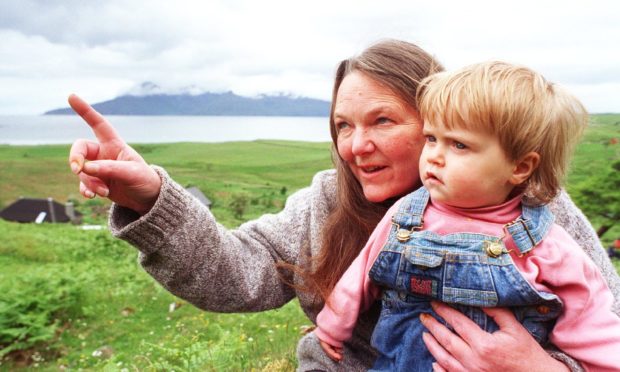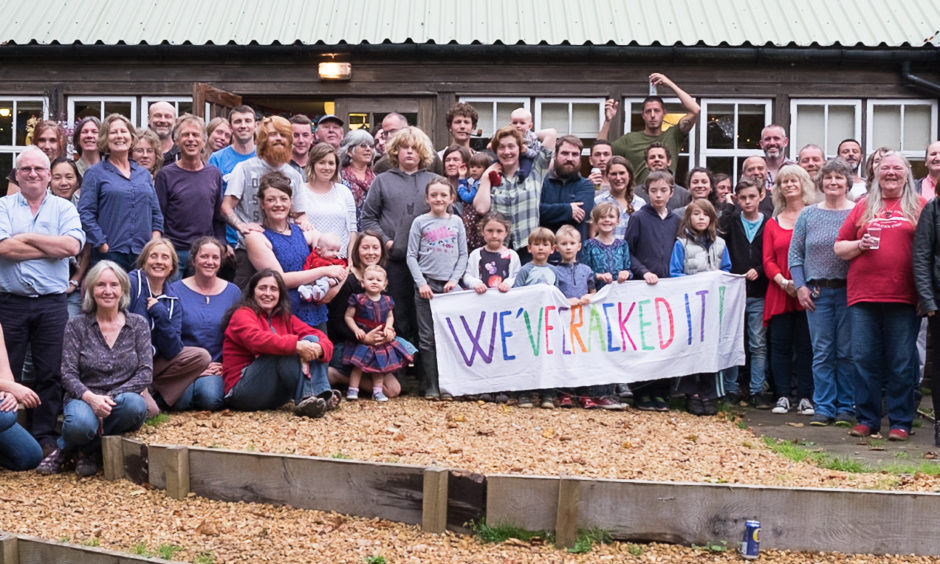Every year Maggie Fyffe sends a Christmas card to a woman she has never met, and whose name she has shared with only a few people.
The identity has remained a closely-guarded secret for more than 20 years despite the pivotal role the woman played in Maggie’s life and in a piece of Scotland’s modern history.
In June 1997, Maggie and the other 67 residents of the island of Eigg became owners of the island where they lived and worked. It was a significant landmark in the land reform movement and a catalyst for further community buyouts.
She had been an Eigg resident for more than 20 years by the time community purchase became a reality.
Aged 28, she and her family moved to the island in 1976 after landlord Keith Schellenberg, the eccentric former Olympic bobsleigher visited a craft centre in Aberdeenshire where she worked and suggested that something similar could be set up on Eigg.
She said: “That’s how it started. Just a random visit. When we first arrived on the island I had no idea if we would stay, but it got hold of me pretty quickly and I soon decided I didn’t want to go anywhere else.”
Over the next few years the reality of life on Eigg, replicated in many parts of the Highlands and Islands, became painfully clear.
Schellenberg had prevented the island from going into public ownership in 1975 by outbidding the Highlands and Islands Development Board and the Fyffe family were one of a few brought in to prop up a population reaching a dangerously low level.
Initial joy and optimism at living in such a beautiful place, in a safe environment for children and being part of a small community, was later overtaken by an air of insecurity with no one having a contract of employment or security of tenure on their homes.
As resentment grew, the idea of community ownership of the island emerged in the early 1990s.
In 1994 when the BBC Speaking Out programme was held on Eigg, Schellenberg said the islanders didn’t know how to be responsible.
Maggie shouted back: “We’ve never had the chance to prove we were responsible.”
Schellenberg later sold Eigg to a German artist known as Maruma, with the islanders’ future again uncertain.
When in 1996 the island was on the market again, a huge, international fundraising appeal was launched for a buyout with a target of £800,000.
The response was overwhelming with letters of support and donations flooding in from all over the world and fundraising events held all over Scotland and as far away as Detroit.
As the closing date for bids approached, Maggie took a call that was as surprising as it was welcome. An anonymous donor wished to pledge £500,000, later amended to £750,000.
After an initial bid failed, the newly-formed Isle of Eigg Heritage Trust, a partnership between the islanders, Highland Council and the Scottish Wildlife Trust, eventually secured the purchase for £1.5 million.
The anonymous donation was crucial. With Gift Aid added, the pledge amounted to £1 million, two thirds of the asking price, but the sole condition was that the donor’s name was not revealed.
“That was the deal, the only string attached”, said Maggie.
“She read about Eigg and our plans for a buyout in a newspaper article and just called me. It’s still amazing today.”
As far as is known, the mystery woman has never visited Eigg, although a friend attended the celebrations when the community secured ownership.
Maggie said: “I’ve never met her, just have a name and address.
“I send her newsletters and a Christmas card and we chat sometimes.
“She is not someone in the public eye, just a wealthy woman who cares about these kind of issues. “
As secretary of the heritage trust, Maggie quickly became known as a leading player in the community ownership movement and has remained in the forefront ever since.
The broadcaster Lesley Riddoch once described her as someone who “walks towards trouble and walks away laughing every time”, a quote used when Maggie was chosen as one of the 100 inspirational women featured in Shauna McMillan’s sculpture Travelling the Distance – which was unveiled at the Scottish Parliament in 2006.
However, at 71, she is now looking towards retirement. Maggie will leave next year with Eigg’s health a stark contrast to the ailing island the residents took over.
Since 1997 the population has risen from 69 to 106, a new generation of people are moving or returning to live there – 13 islanders are now under 40, 12 are school age and six are under five.
Her own daughter Tasha is among the returners and she is now volunteer manager and has been instrumental in establishing the island’s tree nursery.
New houses have been built and businesses started. The island’s self-sufficient renewables system, using three hydroelectric generators, four wind turbines and a photovoltaic array, began providing 24-hour power for the first time in 2008 and will be upgraded soon.
“It’s been far more successful than we could have imagined”, said Maggie.
“The great thing about the population growing is that a few of our young people have come back and they have had babies. What’s attracted them back is they could see things happening here and felt ‘I’d like my kids to grow up like we did’.”
The next milestone will see development on Eigg come full circle.
In 1997 the new owners made their first flagship project An Laimhrig, which houses the island shop, Post Office, tearoom, craft shop, trust office, waiting area and toilet and shower facilities at the pier.
The trust was recently awarded £1m of Lottery money towards the redevelopment of An Laimhrig to provide additional space and new facilities for Eigg’s thriving community.
“It’s interesting that An Laimhrig is now being refurbished”, added Maggie.
“It was the first project we took on and it was finished in time for our first anniversary.
“It seems strange now we are having to extend it ahead of our 25th anniversary, but the place is bursting at the seams.
“Maybe our vision wasn’t that big when we built it, and we had what we thought we needed. But we have now double, perhaps treble, the number of visitors compared to then so it’s much-needed.”
Visitors are now trickling back to Eigg as lockdown restrictions ease. In July, islanders closed all accommodation, as well as its café and restaurant, and asked day trippers campers and sailors to stay away temporarily to protect vulnerable locals.
The decision demonstrated the island’s sense of community.
Maggie said: “We agonised over the decision to close. We have lots of different accommodation providers and all of them said they would rather shut than risk peoples’ health as we have a few elderly people here. It was great that kind of community decision was made.
“But now it’s felt it’s time to start relaxing. It’s been really hard not having people here, but there is also some trepidation about opening up again.”
Retirement offers the prospect for Maggie to go full circle also and return to the craft work that initially lured her to Eigg, as well as more travelling and hopefully visits to the various festivals she has missed this year.
But it will not be the time for her greatest secret to be revealed.
She said: “I’ll take that with me. It’s too important to give it up now.”
Community hub to be upgraded in time for 25th anniversary
The redevelopment of the community building in Eigg will be a flagship project a quarter of a century on from its initial landmark construction.
In July, the Isle of Eigg Heritage Trust was awarded £1m by the National Lottery Community Fund to refurbish and extend An Laimhrig, which currently houses the island’s only shop, café, craft shop and public toilets.
The development has previously secured a Scottish Government Regeneration Capital Grant Fund Award.
The original building, opened in 1998, a year after the community buyout, is now unable to meet the needs of the growing community and its thousands of annual visitors.
With a 70% population increase since the buyout, the trust has focused on building community capacity to ensure growth is sustained through the provision of economic, social and cultural opportunities.
The aim is to secure Eigg’s future for generations of islanders and also provide new space for tourists to learn about the island and benefit from new visitor services.
When finished the building will house an extended shop, with greater storage space, a larger tearoom, better utilising the stunning views south to Ardnamurchan, a larger craft shop, new retail space for Eigg Adventures and improved office and meeting space for community companies and associations, interpretation and new outdoor areas.
It is envisaged the project will be completed in time for the 25th anniversary of Eigg’s buyout in 2022.

